Finds of and research in Ahom coins have revealed fascinating details of Ahom heritage.
“If the sun is once eclipsed, does it not make its appearance again?” was the maxim of the legendary Ahom dynasty that ruled Assam for almost six centuries (1228-1826), holding its own and even keeping the mighty Mughals at bay.
A Tai ethnic group, from the Shan State in north-eastern Myanmar and the adjoining province of Yunnan in south-west China, the Ahom dynasty traces its beginnings in Assam to Chao Lung Sukapha, an Ahom leader, who left his homeland with his followers, crossed the Patkai Range in the early 13 th century and settled at Charaideo, near Sibsagar in Upper Assam.
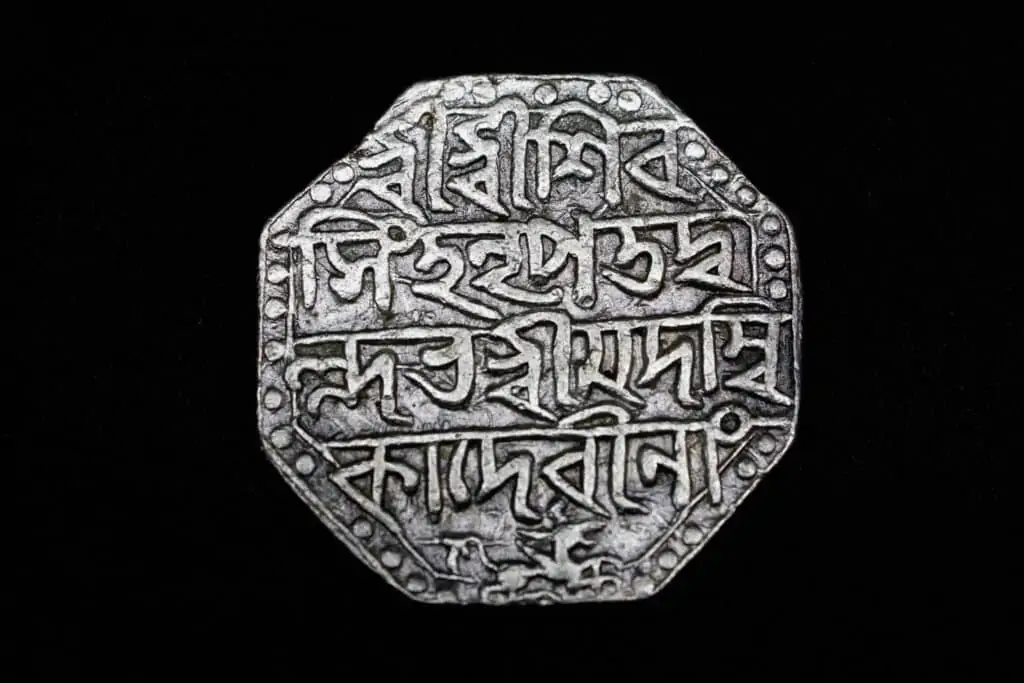
Silver coin of Siva Simha Ahom dated
Saka 1655-1736AD Obverse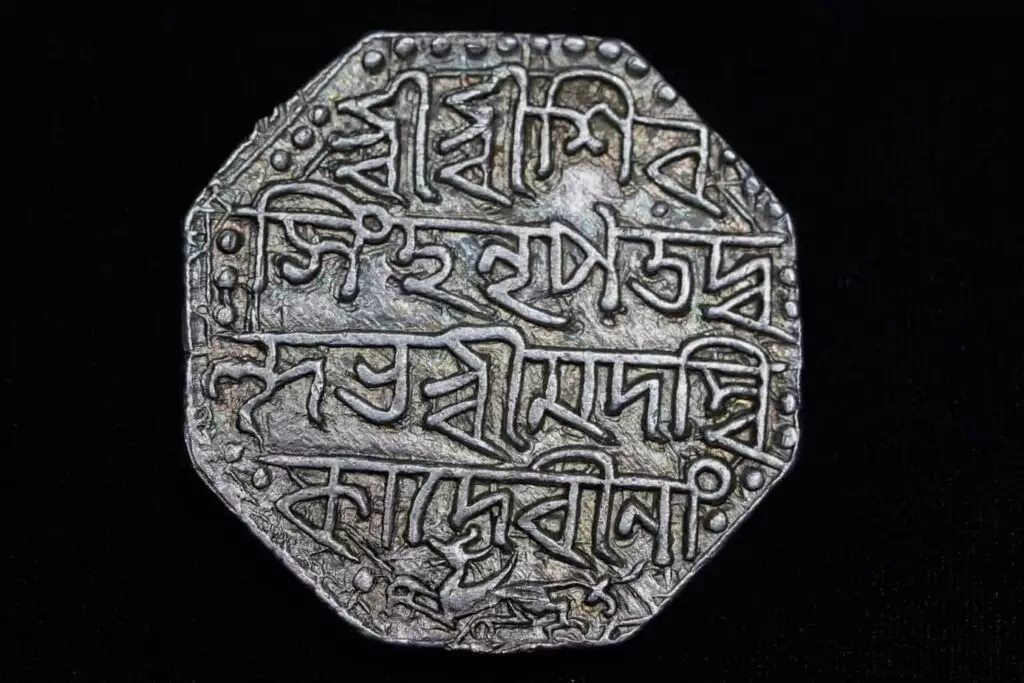
Silver coin of Siva Simha, Ahom, dated Saka 1655 (1736 AD) Obverse 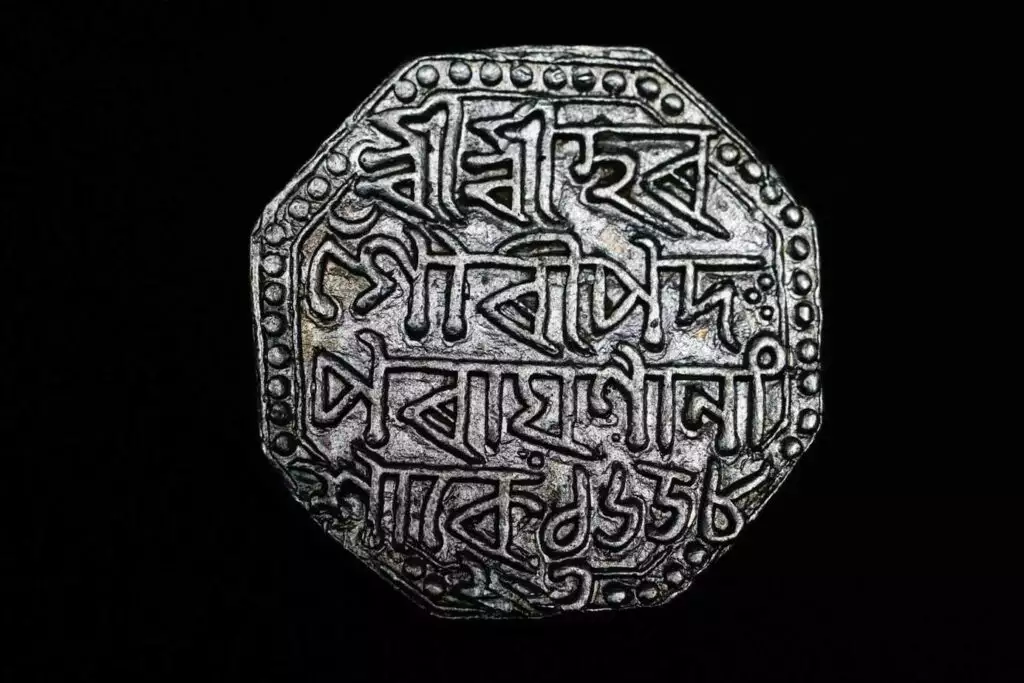
Reverse of Silver Ahom coin of Siva
Simha, Ahom, dated Saka 1658 (1736 AD)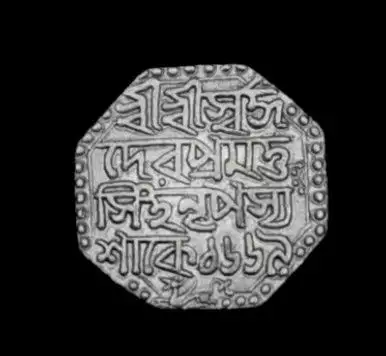
Reverse of Silver Ahom coin of Pramata Simha, Ahom, dated Saka 1669 (1747 AD)
Over the ensuing centuries, the Ahoms steadily expanded their power and went on to govern a vast region of present day Assam. In fact, the modern history of Assam –the name is said to originate from the word Ahom- is often credited with commencing with the arrival of the Ahoms. Most interestingly, the coins issued by Ahom rulers tell of their culture. These coins may be seen in museums like the Assam State Museum in Guwahati and in private collections.
Ahom coinage is particularly fascinating as it traces the history and evolution of a culture and an economy. Though there are early references to coins being issued by rulers to deities, as well as later references to the minting of coins on the accession to the throne of Ahom princes or religious grants, the earliest discovered coins are dated to 1648 A.D.
Yet, even though the extant coins are dated to a relatively short period of about 200 years (1648- 1826), they offer a wealth of priceless information. The early coins bear inscriptions that convey the devotion of the Ahoms to tribal Gods, and inscriptions on later coins tell that- in course of time- they had assimilated Hindu beliefs, as well as the local language and script.
Further, their initial coins bore Ahom legends in Ahom script, which gradually made way for Sanskrit legends in the Assamese script, with the year of issue quoted in Saka Era as prevalent on contemporary Hindu coinage.
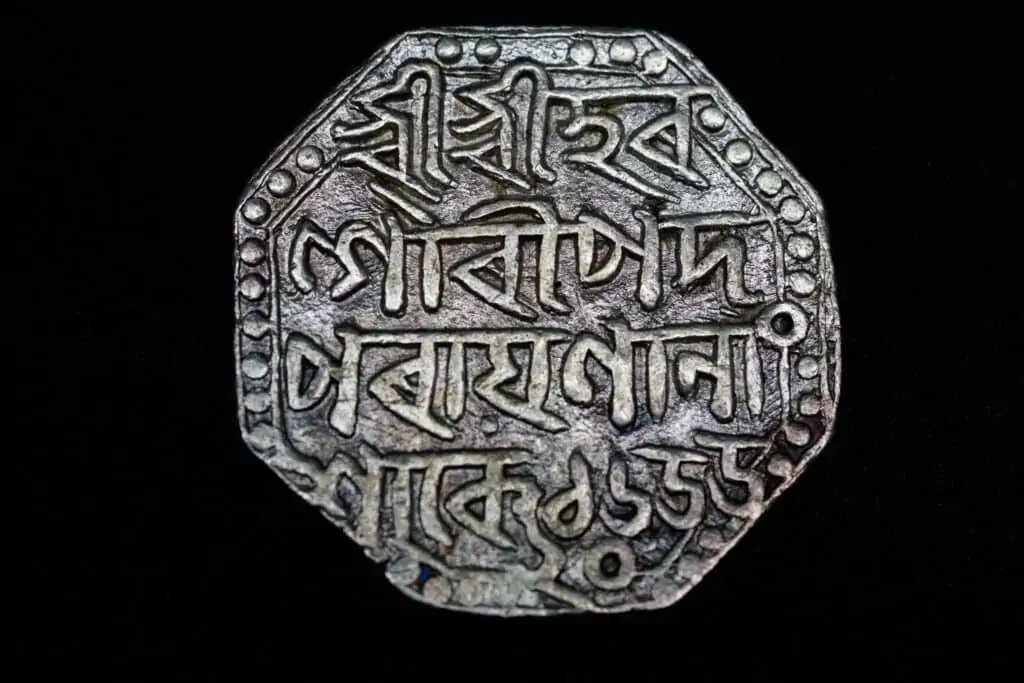
Silver coin of Siva Simha, Ahom, dated Saka 1655(1733 AD) Reverse 
Reverse of Silver Ahom coin of Pramata Simha, Ahom, dated Saka 1669 (1747 AD) 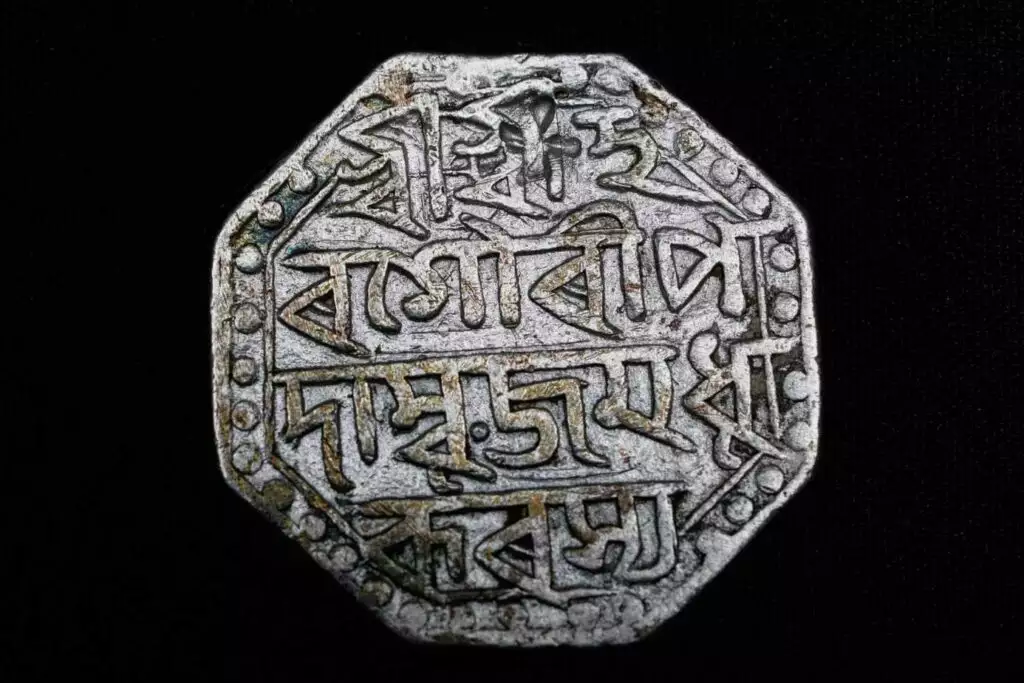
Obverse of Silver Ahom coin of Rudra Simha, Ahom, dated Saka 1629 (1707 AD) 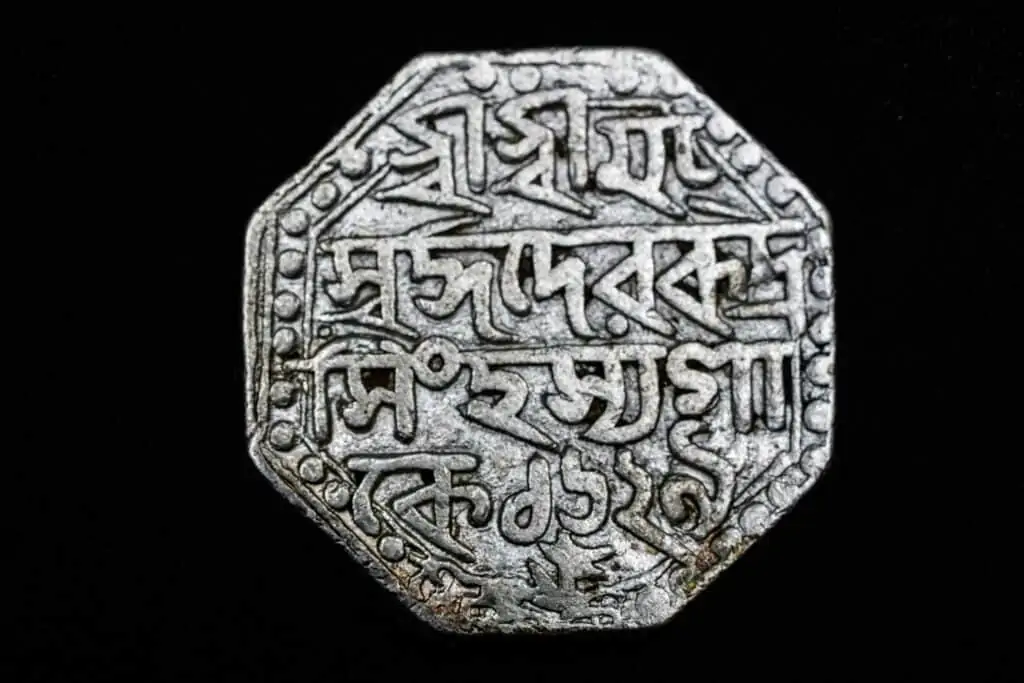
Reverse of Silver Ahom coin of Rudra Simha, Ahom, dated Saka 1629 (1707 AD)
Another important facet of Ahom coinage is that it traces the steady growth and development of their economy from a barter to a money economy. The early Ahom economy, based on agriculture and barter was characteristic of a non-monetized economy. However, over time, responding to the limitations of barter transactions, the Ahom rulers started issuing coinage to facilitate indirect exchange.
Thus, as the Ahom economy gradually moved from a barter to a money economy -an increasing number of coins (predominantly in silver and some in gold were issued); progressively coins of smaller denominations (from rupee to half-rupee, quarter rupee and so forth) were issued; and an increasing volume of coins were issued. Gold coins were rarely used for transactions, which were mostly carried out in silver coins and for small transactions cowries were used; much later, at the end of the 18 th century, copper coins replaced cowries.
This increasing monetization of the economy indicates its increasing economic development of the Ahom kingdom; the establishment of their political and administrative authority over a vast region; as well as prosperity of the treasury from trade, military campaigns or revenue.

Silver coin Ahom King Pramtta Simha, Dated Saka 1669 (1747 CE) 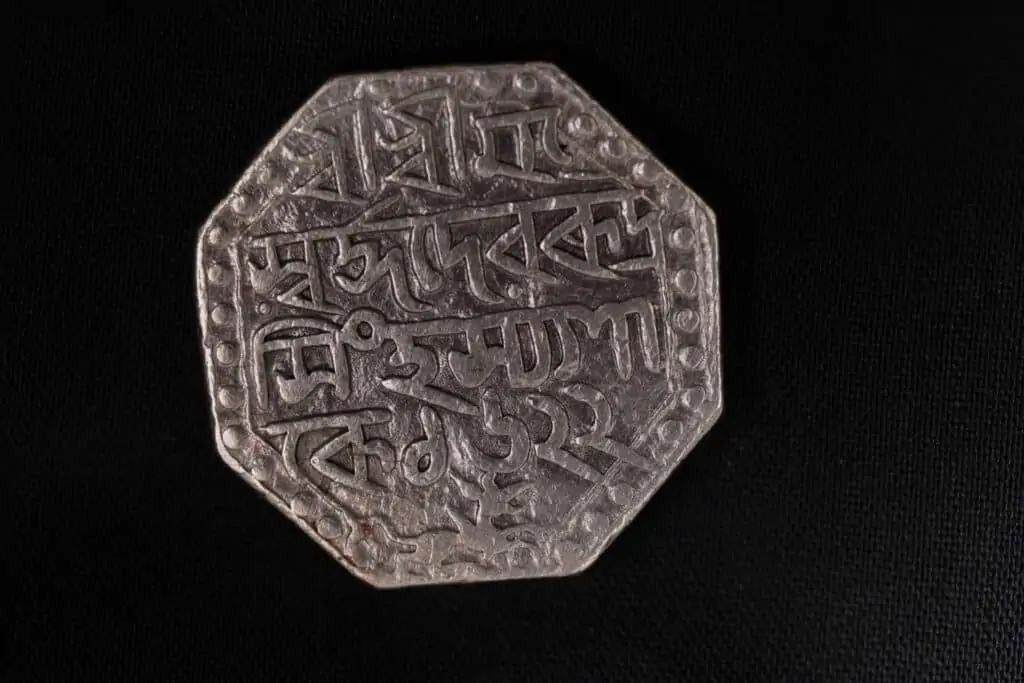
Silver coin of Rudra Simha, Dated Saka 1622 (1700 CE) 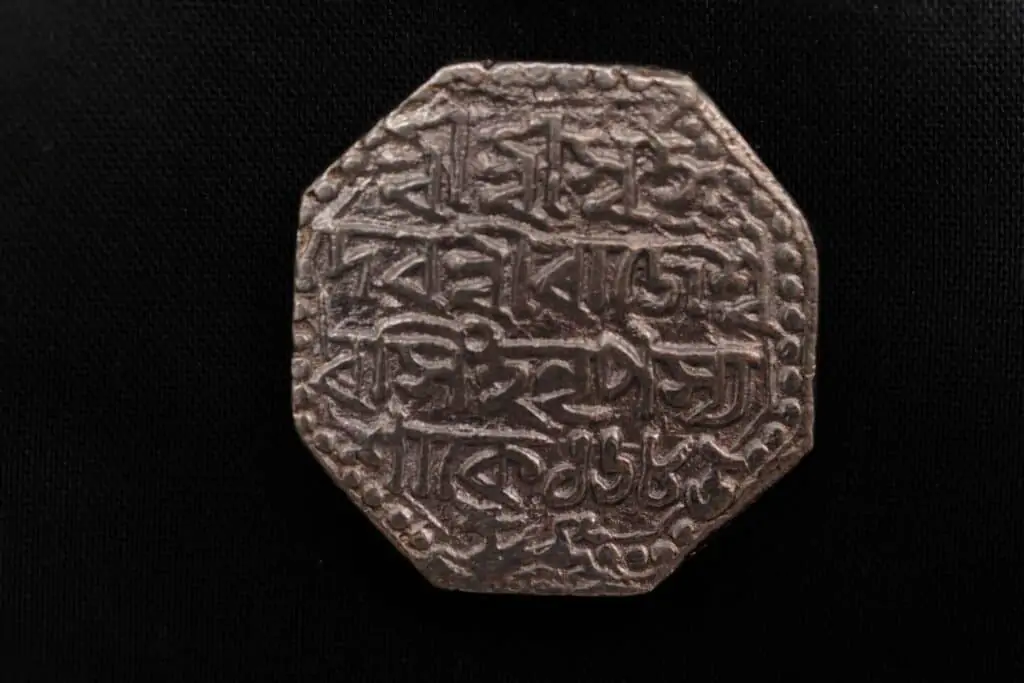
Silver coin of Rajeshwar Simha, Dated Saka 1685 (1763 CE) 
Silver coin of Gadhadhar Simha (1681-96 CE)
The striking feature of Ahom coinage was its octagonal shape. The uniqueness of the shape has invited numerous explanations. A historical manuscript mentions that coins were octagonal to indicate the eight kingdoms subjugated by the Ahoms; while another states that they were so shaped because the Ahom kingdom was described as being eight-sided; and yet another states that as the people had never seen such a large kingdom, as under the Ahoms, they expressed the Ahom domain as one that stretched in the eight directions of earth and space as conceived by the Hindus.
In 1824 the British stepped in to stem the Burmese attempts at gaining power in Assam. By the Treaty of Yandabo in February 1826 the Burmese king gave up claims in Assam. When attempts to reinstate an Ahom ruler failed, Assam was integrated into British India and there was no further independent issue of Ahom coins.
The fascinating history of Ahom coinage has attracted many researchers. As more coins are unearthed and researched, new information and explanations have been and will be presented much to the interest of the numismatist and lay person alike.
About the Author: Brinda Gill, a post-graduate in economics, based in Pune, enjoys discovering the wealth of a nation through its heritage of textiles, culture, arts, architecture and natural life, and writing on these subjects
Image Courtesy: Assam State Museum



4 Responses
A brilliant insight into a rich legacy.
Very nicely portrayed.
Thank you. I hope these articles kindle an interest.
julie
Excellent article !
At a time when few history books in schools cover indigenous cultures, such well researched writings would hooefully kindle interest and restore pride in native traditions.
Thank you. I truly hope it kindles an interest in native cultures.
Julie